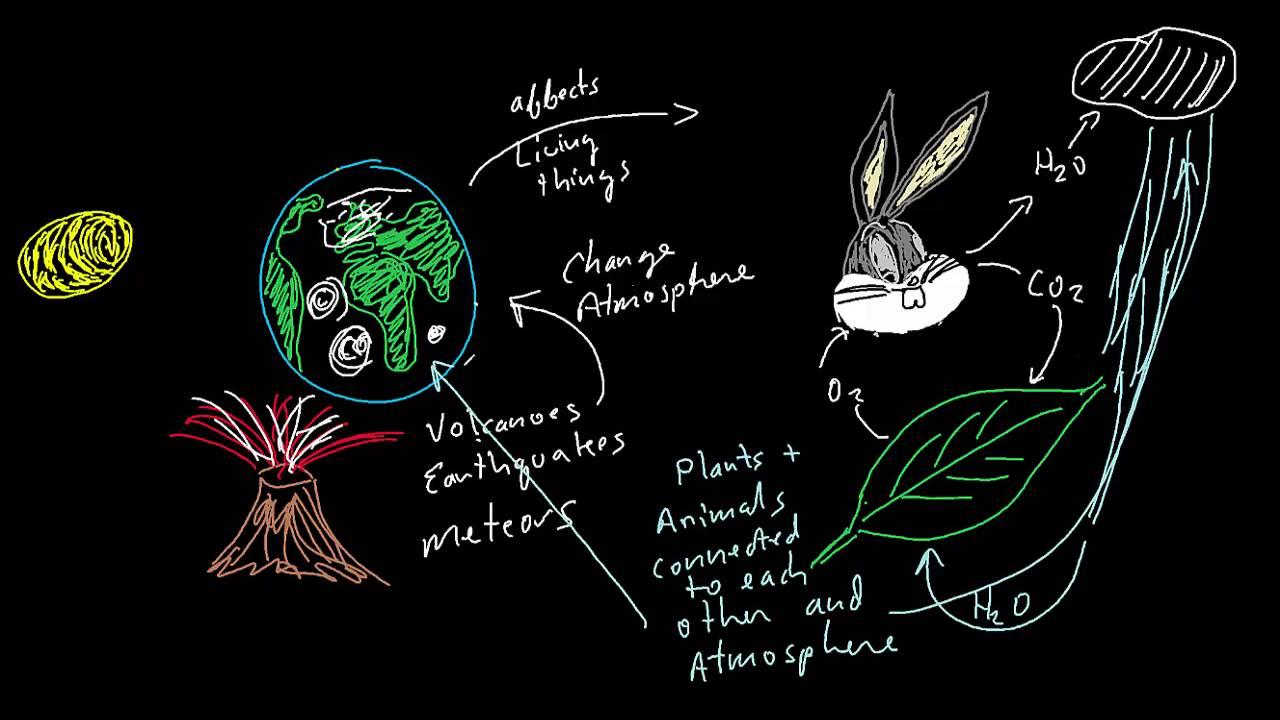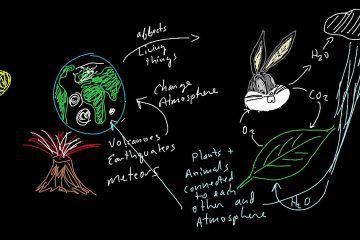Table of Contents
- Understanding the Gaia Hypothesis and Its Key Principles
- Exploring the Visual Representation of the Gaia Hypothesis Diagram
- The Role of Feedback Loops in Earth’s Regulatory Systems
- Implications of the Gaia Hypothesis for Environmental Conservation
- Recommendations for Incorporating Gaia Principles in Sustainability Practices
- Q&A
- To Conclude

Understanding the Gaia Hypothesis and Its Key Principles
The Gaia Hypothesis, proposed by the British scientist James Lovelock in the 1970s, posits that the Earth functions as a single, self-regulating system, where the biotic and abiotic components interact closely to maintain conditions conducive to life. This concept challenges the traditional view that organisms and their habitats operate independently. Instead, it highlights that living organisms play a crucial role in regulating the Earth’s environment, thereby sustaining life over geological timescales. Central to this idea is the belief that life not only adapts to changes in the environment but also actively influences the conditions under which it thrives.
The core principles of the Gaia Hypothesis include:
- Interconnectedness of Life: All living organisms, from the microscopic to the colossal, are interconnected and form a complex web of life.
- Homeostasis: The Earth’s systems work together to maintain stable conditions—temperature, atmospheric composition, and ocean salinity, for example—essential for life.
- Feedback Mechanisms: Living organisms contribute to feedback systems that regulate environmental factors. For example, plants absorb carbon dioxide and release oxygen, modulating atmospheric conditions.
To visualize these principles, the following table summarizes key components of the Gaia Hypothesis alongside their functions:
| Component | Function |
|---|---|
| Atmosphere | Maintains gases essential for living organisms |
| Oceans | Regulate climate and support diverse ecosystems |
| Soil | Holds nutrients and supports plant life |
| Biota | Influences climate and nutrient cycles through various interactions |

Exploring the Visual Representation of the Gaia Hypothesis Diagram
The Gaia Hypothesis challenges us to rethink our relationship with Earth by positioning the entire planet as a self-regulating living entity. This concept is often depicted through intricate diagrams that illustrate biophysical and biogeochemical interactions essential for maintaining ecological balance. The visual representation acts as a roadmap, guiding viewers through interconnected systems that sustain life. Each component, whether it be atmospheric, terrestrial, or aquatic, plays a vital role, emphasizing the complexity of this living system.
By analyzing these diagrams, one can recognize several key elements that amplify our understanding of Gaia’s mechanisms. For instance, the interplay between the biosphere, geosphere, hydrosphere, and atmosphere serves as a foundation. Each sphere not only interacts with the others but also contributes uniquely to the planet’s overall health. Visually, arrows and icons in the diagrams often denote flows of energy and matter, illustrating the seamless connectivity among these crucial elements.
| Element | Role in Gaia Hypothesis | Visual Representation |
|---|---|---|
| Biosphere | Home to all living organisms | Tree symbols illustrating flora |
| Geosphere | Provides minerals and nutrients | Mountain icons |
| Hydrosphere | Regulates temperature and weather | Wave patterns |
| Atmosphere | Houses gases needed for respiration | Clouds and air symbol |
the diagrams not only simplify the complexities of the Gaia Hypothesis but also provoke thought about our role within this intricate system. By viewing Earth through this lens, we are encouraged to engage with the environment more responsibly. The vibrant colors and structured layout of these diagrams highlight the beauty and fragility of life on our planet, inviting discussion on conservation and sustainability as we strive for a harmonious existence with nature.

The Role of Feedback Loops in Earth’s Regulatory Systems
The delicate balance of life on Earth is maintained through various feedback loops that act as regulatory mechanisms within ecosystems. These loops can be classified into two main categories: negative feedback loops, which work to stabilize systems, and positive feedback loops, which can amplify changes. For example, the regulation of temperature through the greenhouse effect illustrates a negative feedback loop; as temperatures rise, ice melts, leading to reduced solar reflectivity and increased warming, prompting a series of effects that maintain a balance if not overridden by excessive greenhouse gas emissions.
Understanding these feedback mechanisms is critical for grasping how natural systems adapt and evolve. They contribute to ecological resilience and sustainability by ensuring that environmental changes prompt corrective responses. Notably, factors such as biodiversity, trophic dynamics, and climate variability all play a part in these loops. For example, an increase in plant diversity can enhance nutrient cycling, which then boosts soil health and supports more robust ecosystems in a reciprocal relationship. These interactions foster a comprehensive network of life, whereby organisms and their environments co-evolve.
When considering human impact, these feedback loops are even more pivotal. Anthropogenic actions, such as deforestation and pollution, disrupt natural feedback mechanisms, leading to ecological instability. A table illustrating some human actions alongside their potential feedback outcomes highlights this urgency:
| Human Action | Potential Negative Feedback Loop | Potential Positive Feedback Loop |
|---|---|---|
| Deforestation | Loss of habitat encourages species migration, potentially restoring balance | Increased carbon emissions lead to climate change, raising temperatures |
| Overfishing | Restoration of fish populations through marine protected areas can stabilize ecosystems | Collapse of fish stocks leads to loss of predator-prey relationships |
| Urbanization | Green spaces in cities can enhance local biodiversity and air quality | Heat islands exacerbate climate extremes |
By acknowledging the complexities and significance of these feedback loops, we can better appreciate the intricate web of life on Earth. Our role is to understand and support the processes that allow these systems to thrive, ensuring a harmonious relationship with our planet’s ecosystems.
Implications of the Gaia Hypothesis for Environmental Conservation
The Gaia Hypothesis, posited by James Lovelock, presents a fascinating perspective on how the Earth’s biological and physical components interact to create a self-regulating system. Understanding this hypothesis opens new doors for environmental conservation efforts, emphasizing the interconnectedness of all living organisms and their environment. This perspective encourages a holistic approach to conservation, wherein the health of ecosystems is paramount for the survival of humanity itself. By recognizing that human activities disrupt the delicate balance within this system, practitioners of conservation can develop strategies that enhance biodiversity, promote sustainability, and restore natural habitats.
To implement effective conservation strategies aligned with the principles of the Gaia Hypothesis, several key implications emerge:
- Interconnectedness: Conservation efforts must consider the relationships between species and their habitats, recognizing that the loss of one species can have far-reaching effects.
- Sustainability: Practices focused on sustainability become essential, ensuring that natural resources are used responsibly and regeneratively.
- Restoration: Restoration of damaged ecosystems should be prioritized, as promoting resilience enhances the Earth’s self-regulating capabilities.
Additionally, movement towards environmentally conscious policies can be enhanced by embracing these implications. For instance, integrating ecological principles into urban planning can lead to more sustainable cities. Engaging communities in conservation efforts not only fosters stewardship but also empowers individuals to see themselves as integral parts of the Earth’s system. Below is a summary of the potential benefits of implementing Gaia-inspired conservation strategies:
| Strategy | Potential Benefit |
|---|---|
| Habitat Restoration | Enhances biodiversity and ecosystem resilience. |
| Sustainable Resource Management | Ensures resources for future generations while maintaining ecosystem balance. |
| Community Engagement | Fosters a sense of responsibility and connection among individuals, enhancing conservation efforts. |

Recommendations for Incorporating Gaia Principles in Sustainability Practices
Incorporating Gaia principles into sustainability practices involves embracing the interconnectedness of all living organisms and their environments. To effectively implement these principles, organizations and individuals can consider the following strategies:
- Holistic Assessment: Evaluate the impacts of actions not just on immediate surroundings but on the larger ecosystem. This means looking beyond profit margins to include ecological and social factors.
- Systems Thinking: Adopt a systems-oriented approach that recognizes the complex web of life. This involves understanding the relationships between various components of the environment and how they influence each other.
- Collaborative Efforts: Engage with community stakeholders, local authorities, and environmental organizations to co-create solutions. Collaboration fosters a sense of responsibility and shared purpose, essential in addressing global challenges.
To visualize how these practices can translate into actionable steps, a useful approach might involve creating a matrix that charts current sustainability practices against Gaia principles. This comparison can help identify gaps and areas for improvement:
| Current Practice | Alignment with Gaia Principles |
|---|---|
| Waste Reduction Programs | Enhances ecosystem health by reducing landfill impact. |
| Sustainable Supply Chain Management | Promotes biodiversity and reduces resource depletion. |
| Community Development Initiatives | Supports social cohesion and ecological resilience. |
continuous education and awareness-raising are critical in fostering a culture that prioritizes Gaia-centric sustainability. Workshops, seminars, and digital platforms can be utilized to share knowledge about the interrelationships between ecosystems and human activity. By empowering individuals with the right tools and understanding, we can cultivate a more sustainable future where all life thrives in harmony.
Q&A
Q&A: Understanding the Gaia Hypothesis Diagram
Q1: What is the Gaia Hypothesis, and why is it significant? A1: The Gaia Hypothesis, proposed by scientist James Lovelock in the 1970s, suggests that Earth functions as a self-regulating system, where biological processes and physical components interact synergistically. Its significance lies in emphasizing the interconnectedness of life and the environment, prompting discussions on ecology, climate change, and how human activities impact planetary health.Q2: What does a Gaia Hypothesis diagram typically depict? A2: A Gaia Hypothesis diagram often illustrates the complex interactions between living organisms (biosphere), the atmosphere, hydrosphere, and lithosphere. It visually represents how these components influence each other, highlighting feedback loops. For instance, how plant respiration affects atmospheric composition, which in turn influences climate patterns.
Q3: How can the Gaia Hypothesis diagram help in understanding ecological balance? A3: By visualizing the relationships and feedback mechanisms within Earth’s systems, the diagram aids in grasping the notion of ecological balance. It showcases how perturbations in one component can lead to cascading effects elsewhere, fostering an awareness of the delicate equilibrium that sustains life.
Q4: Are there different versions of the Gaia Hypothesis diagram? A4: Yes, there are various interpretations of the Gaia Hypothesis diagram. Some may focus more on specific ecosystems, while others present a broader perspective of the Earth as a whole. The style, complexity, and elements included can vary based on the audience—scientific, educational, or general public.
Q5: What are some criticisms of the Gaia Hypothesis, and how are they illustrated in diagrams? A5: Critics argue that the Gaia Hypothesis can anthropomorphize Earth, suggesting it has intent or purpose, which may not align with scientific understanding. Diagrams may illustrate these criticisms by deliberately depicting the limits of biological regulation or emphasizing that Earth’s systems can be resilient yet vulnerable to human influence and environmental disruption.
Q6: How can one interpret a Gaia Hypothesis diagram effectively? A6: To interpret a Gaia Hypothesis diagram effectively, focus on the connections between different components. Take note of arrows or lines indicating flow or relationships, such as nutrient cycles or energy transfer. Understanding these interactions offers insights into ecosystem health and the impact of human actions.
Q7: How does the Gaia Hypothesis relate to current environmental issues? A7: The Gaia Hypothesis is increasingly relevant in discussions about climate change, biodiversity loss, and sustainability. By illustrating how human activities disrupt the delicate balance of Earth’s systems, the diagram serves as a visual call to action, advocating for practices that promote ecological harmony and planetary health.
Q8: Where can I find examples of Gaia Hypothesis diagrams? A8: Examples of Gaia Hypothesis diagrams can be found in academic textbooks on ecology and environmental science, online educational platforms, and reputable scientific websites. Exploring these resources can provide a deeper understanding of Earth’s interconnectedness as proposed by the hypothesis.
This Q&A aims to elucidate the Gaia Hypothesis and its diagrams, guiding readers through the intricate web of life and the environment.



0 Comments